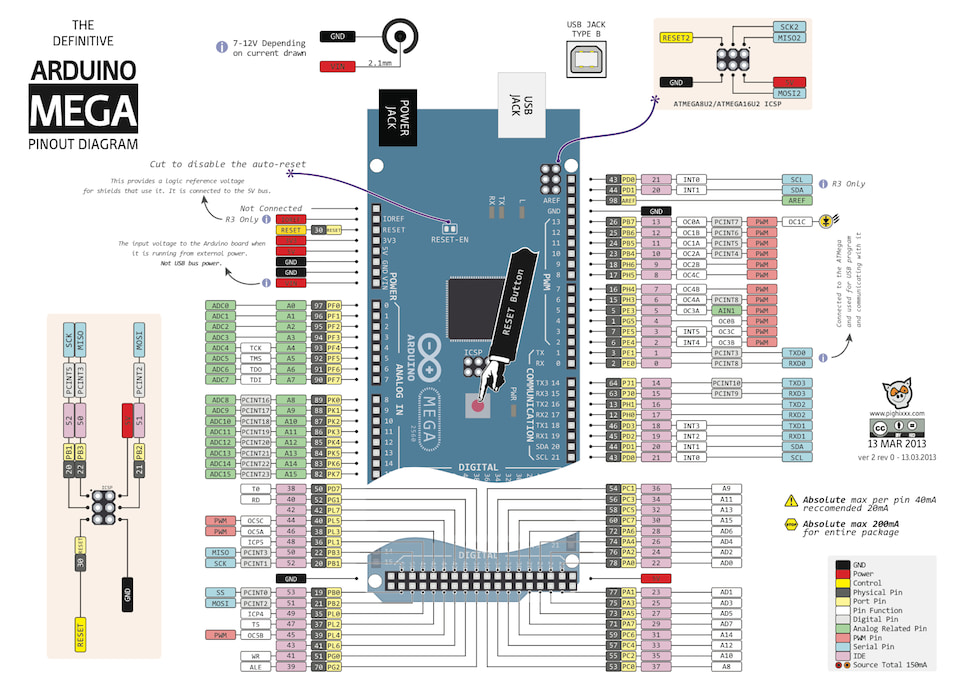Out Of Stock
Notify me when its in stockArduino Mega 2560 is a microcontroller board based on Atmega2560. There are 54 digital I/O pins (15 of them are PWM out),1 6 analog input pins, 4 UART (physical serial port), a 16 MHz crystal oscilator, an USB socket, a power socket, an ICSP connector and reset button on the board. There are the all essential parts on the board for microcontroller operations. The board can easily be connected to the computer via usb or can be used with an external adapter of battery.
Arduino Mega has an Atmega16u2 (It was Atmega8u2 on the Rev 2 model) usb - serial chip for programming and communicaiton with computer via usb.
Arduino.cc made various innovaitons on the Rev 3 in comparison with Rev 2 to be useful and stable. The Arduino Mega board has been a referance model as both software and hardware to all the other Arduino models. You may see the historical development of the Arduino boards by hardware index.
Features:

Power:
Arduino Mega can be supplied via usb or an external voltage source. External voltage source would be an AC - DC adapter or a battery. When it is supplied with an external adapter or battery, using 2.1 mm width, center-positive, 7-20 V power supply is recommended. Moreover, the connectors of the power socket on the board, Vin and GND pins are short circuited in beckend. The battery can be connected to the board via GND and Vin pins.
It is not necessary to be connected to usb port during whole the operation. The board can be energized with only an adapter or a battery too, by this way, the board can work independently from the computer.
6 - 20 V can be used as an external supply but these are the limits for Mega. Recommanded voltage supply for this board is between 7 - 20 V. Becouse the regulator on the board might not work stabile for the voltages below 7V. Likewise, it can be over - warmed for the voltages above 12 V.
Operating voltage of the Arduino Mega's microcontroller is 5 V. The voltage supplies the board via Vin pin or the power socket on 7 to 12, V then this voltage is regulated and distributed to the board by the regulator.
Power pins are like that:
Memory:
Atmega2560 has an 256 kB flash memory (8 kB of this is used by the bootloader), 8 kB SRAM and 4 kB EEPROM.
Input and Output:
All of the 54 digital pins on the Arduino Mega board can be configured both as an input or an output. There are 16 analog input pins on the board too. All of these analog pins can be configured as digital input or output. In total there are 70 digital input - output pins on the board. Logic level of these pins are all 5 V. All of these pins are able to provide an output current up to 40 mA. Additionally, some of these pins have diffrent features too, listed below:
You may view the page from this link.
Communication:
There are several options for Arduino Mega to communicate with another arduino or microcontroller. Atmega2560 provides 4 UART TTL (5V) Serial communications via its 0 (RX) and 1 (TX) pins. Atmega2560 connects to a computer by opening a virtual serial COM port and allows the serial communication. Arduino IDE, thanks to its serial monitor find in the computer software, provides to send and recieve text based information. RX and TX leds on the board blink while the board is communicating via USB.
There is a phsycally serial port on the Mega board but this number can be increased with the SoftwareSerial library as software.
Atmega2560 provides I2C and SPI ports too. Wire library if to use I2C and SPI library is for SPI communication.
Programming:
Arduino Mega board can be programmed with the Arduino computer software (Arduino IDE). You can start programming by choosing Arduino Mega under tools > board menu on the Arduino IDE. For details you may see the referance and the basic functions page. Atmega2560 on the Arduino Mega board comes together with a specific software installed, named bootloader. Thanks to this it is not needed to use an external programming device to program Arduino Mega. Communication is supplied by and original STK500 protocol.
The board can be programmed by using ICSP headers via ISP programmer instead of bootloader software (Referance).
Like the bootloader software, the source code in the Atmega16u2 is opensource. This software is named DFU bootloader. This software can be re-uploaded by using Atmel's FLIP software (Windows) or DFU programmer (Mac OS X and Linux) or can be re-programmed with 16u2 and ISP like Atmega2650. Both Atmega2560 and Atmega16u2 comes with the current revisions so it is not needed to chane these codes.
Usb high current protection:
Arduino Mega board has restarable high current protectors. Even if your computer has its own protectors for its USB ports, the protectors on the board is adjusted to reject more than 500mA. If this amount of current is reached, protectors will keep open - circuit the connection untill the short - circuit disappears.
If you are not sure which Arduino to choose, you may contact us bu filling the form.
Note: There is just Arduino Mega R3 in the content of the product, not usb cable and external adapter. You may see the Combo Kit to buy them together for a less price.
Documents: